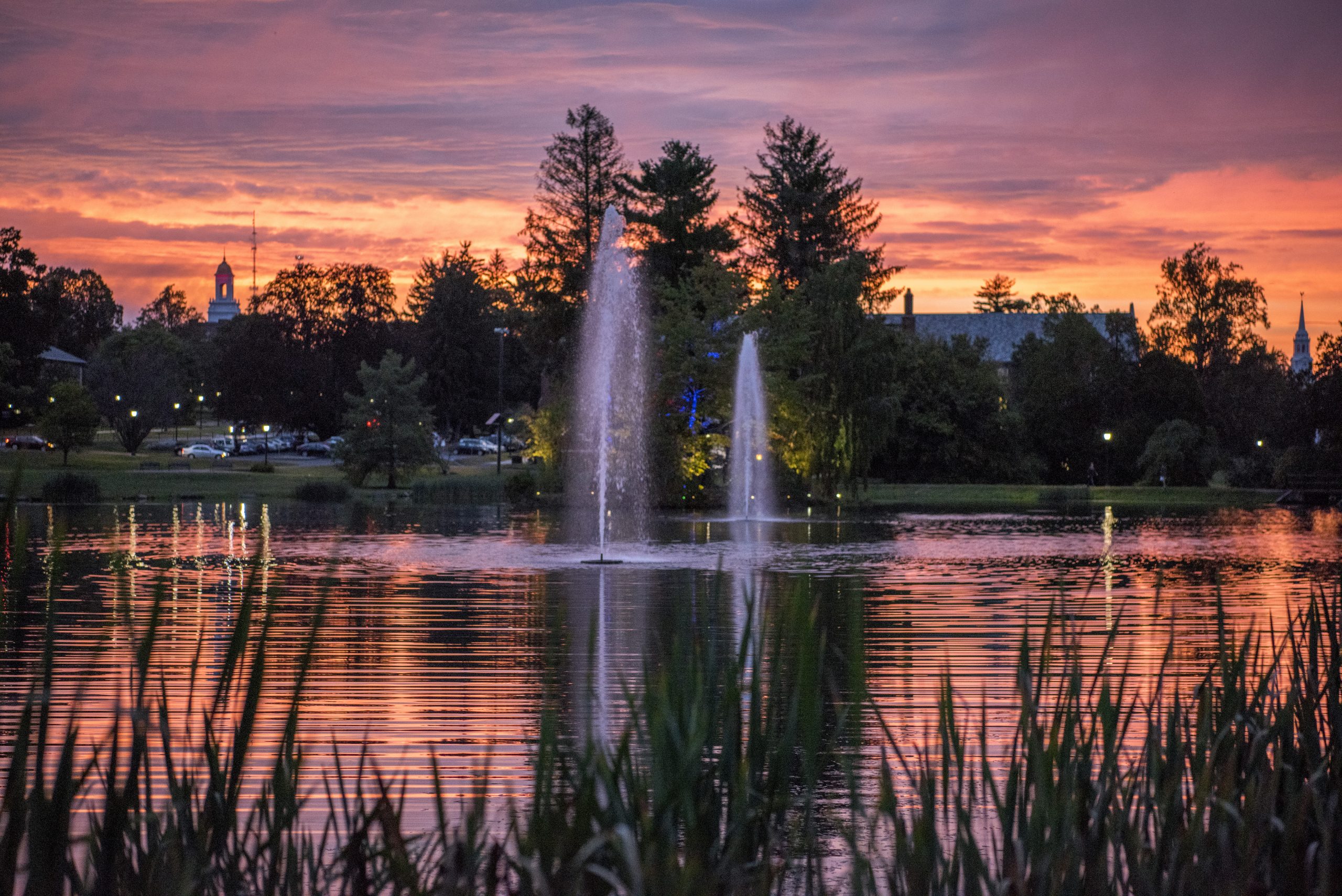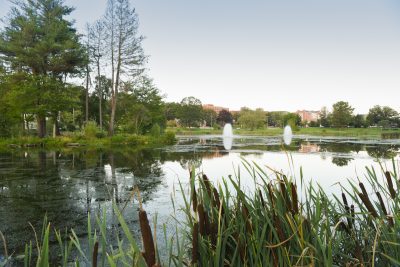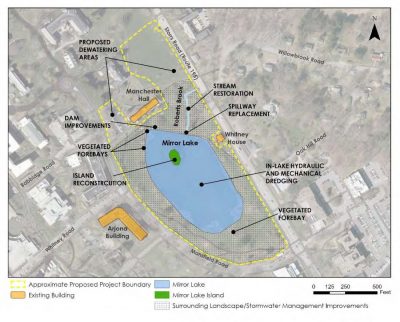
Sunset over Mirror Lake on Sept. 19, 2016. (Ryan Glista/UConn Photo)
Project Scope Reduced due to Budget Constraints
As published in UConn Today on May 5, 2023 and the result of working group meetings with CT DEEP surrounding the Roberts Brook Watershed:
UConn is redesigning its project to improve Mirror Lake to address flooding and stormwater runoff concerns, holding off for now on dredging that had been planned to deepen it by removing decades’ worth of built-up muck.
The Board of Trustees this month approved funding to revise the project’s design, which will entail improvements determined in consultation with the state’s Department of Energy and Environmental Protection.
They will focus on two safety and compliance elements: improvements and/or repairs to Mirror Lake’s dam and spillway, which pose flooding hazards during heavy rain; and stormwater control and water quality improvements associated with construction of the nearby South Campus Residence Hall and related infrastructure work.
Mirror Lake is visibly shallow, murky, and weedy during periods of the year, and contains several feet of organic muck and sediment from the 50 years of development on and off campus nearby. Stormwater runoff from its 165-acre Roberts Brook watershed, which includes non-UConn property, has flowed toward the lower-lying lake for nearly 100 years, impacting water quality and increasing the volume.
UConn originally had planned to also dredge the lake to help maintain its existing footprint during storm events and reduce the need to increase the height of the dam that would be necessary for flood control and dam safety. However, it decided to reduce the scope amid University-wide budget constraints.
The work is expected to begin in August 2024 once the design, permitting, and construction bidding processes are complete, and to conclude within about one year.
Unlike UConn’s Swan Lake to the north, Mirror Lake isn’t a natural water body. It originally was a marshy meadow just off campus when UConn began as the Storrs Agricultural School in 1881, and later became part of the institution’s property.
By 1910, landscape architects already were proposing turning it into a human-made lake, both as an aesthetic feature and landmark of the central campus, and to find an appropriate use for the otherwise swampy, insect-friendly marsh.
Around 1922, the wooden dam on the marsh’s northern side was removed, a new soil dam was created, and about four acres were flooded to create Mirror Lake. It was fully dredged in 1946 and partially dredged in 1970, but sediment from stormwater runoff has made it continuously shallower and excrement from geese, gulls, and ducks, and other pollutants have affected the water’s quality.
UConn conducts annual maintenance programs, including cleaning and treatments, to combat algae growth. The addition of two fountains has also helped mitigate some of the algae blooms, although those fountains are currently inoperable because their electrical connection is sourced near the adjacent fire-damaged Whitney House.
However, the capacity of Mirror Lake has been so greatly reduced by sediment that during heavy rainfalls, water occasionally flows over the banks of the brook originating at the dam’s spillway, becoming temporarily impounded at downstream culverts.
UConn took over dam inspection and assessment processes in 2016 from DEEP due to changes to Connecticut dam safety regulations.
After its 2019 assessment, Mirror Lake’s dam was deemed a higher safety hazard than before, moving it into a hazard class defined by DEEP in which failure would result in probable life/safety issues and impacts to Route 195, secondary roads, and other downstream impacts.
UConn conducts regular maintenance, including temporary repairs enacted in 2020 to the dam’s spillway and surrounding area.
The planned work will help resolve the flooding issues, although University officials acknowledge dredging and site improvements that were planned around the lake will need to be revisited when capital budget funding allows it.
Background Information for Original Project
PROJECT PURPOSE
Mirror Lake has been a beloved and historic campus landmark since 1922. After multiple decades of deferred maintenance; accumulating silt, sediment and pollutants; significant campus development within its watershed over the same period of time resulting in an undersized stormwater facility; and, a damaged spillway and a dam that recently received an elevated hazard classification, various improvements to Mirror Lake are now essential. Numerous studies recently completed for Mirror Lake – an unimplemented dredging plan in 2012, a campus master plan and water quality assessment in 2015, a campus drainage master plan in 2018, a dam inspection report in 2020, and a feasibility study in 2021 – each concluded with recommendations for the University to take action.
This project will design and construct improvements that were identified in the feasibility study and satisfy requirements of the campus drainage master plan in order to execute an MOU between UConn and DEEP and a master flood management certificate (FMC) for the Roberts Brook watershed. The improvements will also support other project milestones and planned openings within the watershed, such as the proposed South Campus Residence Hall and its enabling infrastructure.
The Mirror Lake Improvements project is currently in the Design Phase with anticipated design completion in Fall 2022. Construction is anticipated to begin in Spring 2023 with a Construction Manager and be complete in Fall 2024.

Record of Decision
The proposed project consists of the following elements:
- Dam safety improvements, including replacing the existing spillway with a stepped spillway and raising the dam’s earthen embankment
- Stormwater management improvements, including the rerouting of several discharge points into sedimentation forebays and regrading of upstream and downstream slopes
- Dredging and improvements to aquatic ecosystems, including the use of hydraulic and mechanical dredging to remove accumulated sediments and restore the lake depth
- Landscape improvements, including littoral zone plantings and site-specific amenities that enhance cultural benefits and improve access to the water’s edge
Name: Ian Dann, Project Manager
Agency: University of Connecticut, University Planning, Design and Construction
Address: 3 Discovery Drive U-6038, Storrs, Connecticut 06269-6038
Phone: (860) 486-6503
E-Mail: ian.dann@uconn.edu
Inquiries and requests to view and or copy documents, pursuant to the Freedom of Information Act, must be submitted at https://publicrecords.uconn.edu/make-a-request.
What happens next: The University has submitted the Record of Decision to the Office of Policy and Management (OPM) for review. OPM's determination regarding the Record of Decision will appear in a future edition of the Environmental Monitor.
